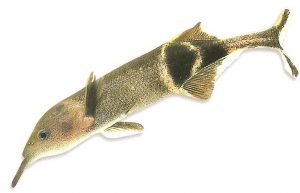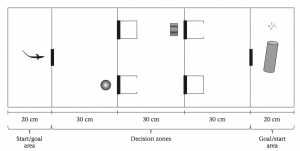Animals may not have the benefit of GPS the way we do, but this does not mean that their navigational strategies are any less sophisticated. To scavenge for food, mate, or even find refuge, animals have to gain information about their environments and properly use it to navigate to the intended goal. Most animals are able to use combinations of multiple senses to find their way around and the variation in the inputs to their sensory system may influence navigational strategy. Understanding the range of an animal’s sensory system can inform what strategies they use and with how much flexibility.

Gnathonemus petersii https://commons.wikimedia.org/wiki/File%3A
Gnathonemus_petersii.jpg
A study by Schumacher et al. investigated these conjectures about sensory influence by experimenting with the navigational strategies of the fish Gnathonemus petersii. This fish has a weakly electric sense, meaning that it can produce electrical pulses and detect how they distort in the immediate surroundings; these distortions inform it of objects within the range of the pulses. Furthermore, like most non-cave dwelling fish, it can also use vision to navigate its surroundings. The spatial resolution of G. petersii is poor but it is able to take in enough light to see in turbid water, and the coupling of this with its electric sense allows for good navigational skills.

A top-down view of the maze the researchers used. The open doors are accompanied by simple landmarks the fish would be able to sense.
The researchers created a simple maze that ended with desirable food and shelter for the fish, and had doors for the correct paths marked with simple landmarks. Using strategies to isolate one of the senses at a time, the researchers were able to train the fish on the course using either the electric or visual sense, and then later manipulate the course to see what strategies they used to find the end again.
Their results showed that the fish who were trained with just the visual sense learned the course better, but also that they were more likely to use egocentric cues (internal and learned) over allocentric cues (sensing the landmarks) when the landmarks were moved. However, the fish still used allocentric cues when trained visually as a way to initially acquire knowledge about the correct route.
What these results suggest first and foremost is that G. petersii navigate significantly through memory of an environment. This makes sense because they live in an unstable river environment and thus must rely on knowledge of where they’ve been over environmental cues that may be in constant flux. The researchers also were able to confirm that the fish are flexible in their strategies and that they are able to use both the electric and visual sense as a navigational mechanism. The electric sense was best for perceiving fine-scale objects at close range, while the visual sense provides a broader method of detecting large landmarks.
Overall, these results reveal the importance of having and utilizing a flexible multisensory system, especially under changing conditions. G. petersii have an advantage in their ability to switch sensory systems when the input changes, and this provides knowledge about how environmentally adaptable animals are in terms of their sensory systems.
References
Schumacher, S., von der Emde, G., & Burt de Perera, T. (2017). Sensory influence on navigation in the weakly electric fish Gnathonemus petersii. Animal Behaviour 132, 1-12.
